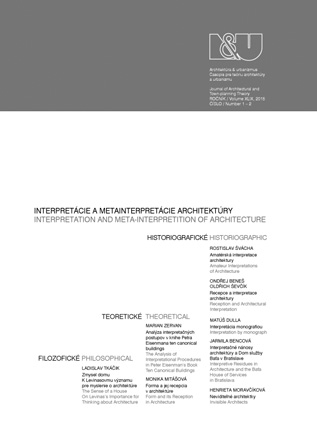RECEPCE A INTERPRETACE ARCHITEKTURY: TELEVIZNÍ VĚŽ A HOTEL JEŠTĚD A TELEVIZNÍ VĚŽ V PRAZE-ŽIŽKOVĚ
RECEPTION AND ARCHITECTURAL INTERPRETATION: THE TELEVISION TOWER AND HOTEL JEŠTĚD AND THE PRAGUE-ŽIŽKOV TELEVISION TOWER
Author(s): Oldřich Ševčík, Ondřej BenešPublished by: Historický ústav SAV, v. v. i.
Keywords: public reception; architectural interpretation; tower building type; post-war modernism; Television Tower and Hotel Ješted Liberec; Prague-Žižkov Television Tower; identity; context; monumentality
Summary/Abstract: The paper focuses on the problem of the public or architectural interpretation and reception of two extraordinary buildings: the combined hotel and television tower on Mt. Ještěd near Liberec and the Žižkov Television Tower in Prague. The paper is divided into three chapters: 1) Architecture and the Historic Context, 2) Architecture and the Topological (Landscape or Urban) Context, 3) “Architecture – Technology – Context” Relations. Both of the buildings addressed are discussed in terms of their program (television transmission, hotel, skyline restaurant, etc.). Each of them was designed and built under different social circumstances: either at the turn of the 1960s and 1970s (TV-Tower and Hotel Ještěd, designed and built 1966–1973) or at the turn of the 1980s and 1990s (TV-Tower in Prague-Žižkov, designed and built 1985–1992). The public reception of these buildings demonstrates minor similarities alongside the prevailing dramatic differences, forming the subject of further description, analysis and interpretation. The Ještěd TV tower had to face public disagreement, negative criticism and a definite aversion during the public presentation or the “nomination” of its architectural project. Extraordinary technical and engineering solutions were developed for this tower (among them the special pendulum designed by structural engineer Zdeněk Patrman). After the completion of the tower, it nonetheless won both the continuing sympathy of the public and highly positive architectural assessments. Designed by architect Karel Hubáček, the Ještěd TV tower is widely acclaimed for reconciling the viewer to its own monumentality, thanks to the complex and delicate formal, structural, technical and technological intricacy. It also reconciles both the public and architects to all the possible meanings proven over time to form its inherent canonical values. This building at the peak of Ještěd – a hyperboloid volume growing from the mountaintop towards the sky – was predestined by its topos at least as much as Fallingwater – the Kaufmann Residence by Frank Lloyd Wright. Nature and landscape context became an intrinsic inner quality of this architectural work. The meaning of Hubáček’s and Patrman’s Ještěd building is not reduced to the acceptance of the “high-tech” elements – even if the adoption of high-tech architecture is an important event in the history of Czech architecture. According to Beneš and Ševčík, this very building is itself a special event characterizing the architectural scene thanks to its fulfilled aspirations: an achievement of the balance and harmony of the relationship “architecture – technology – context”. The TV tower in Prague-Žižkov stands out thanks to its formal originality, consisting of a tower formed by three tubular posts instead of one expected unified shaft. Together with the round corner capsules (cabins) placed on three separate levels, these tubular posts make the massive building more “soft”. Thanks to these cabins, ...
Journal: Architektúra & Urbanizmus
- Issue Year: 49/2015
- Issue No: 1-2
- Page Range: 26 - 43
- Page Count: 18

